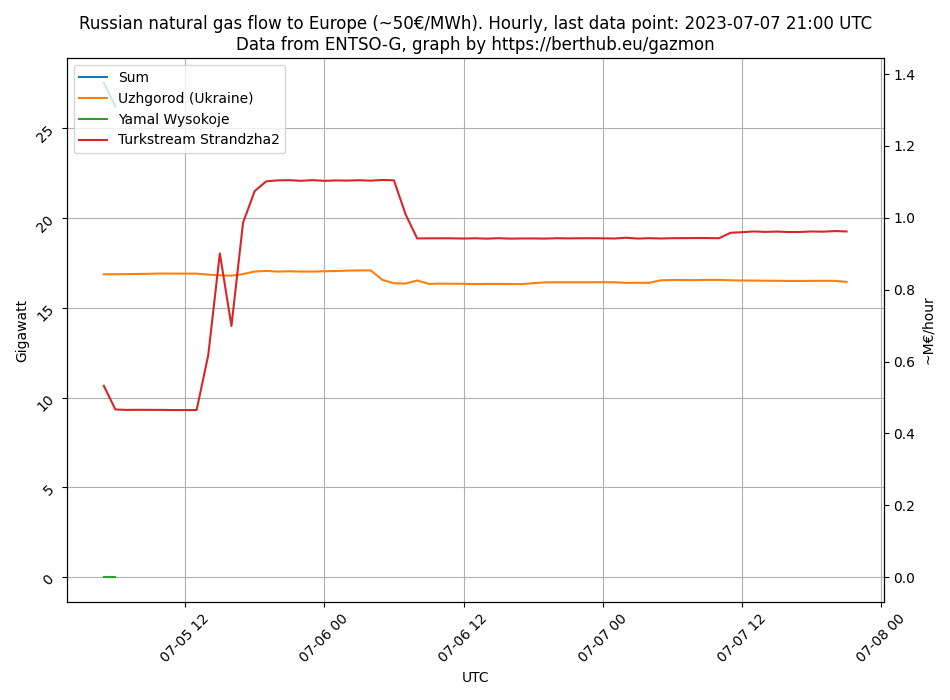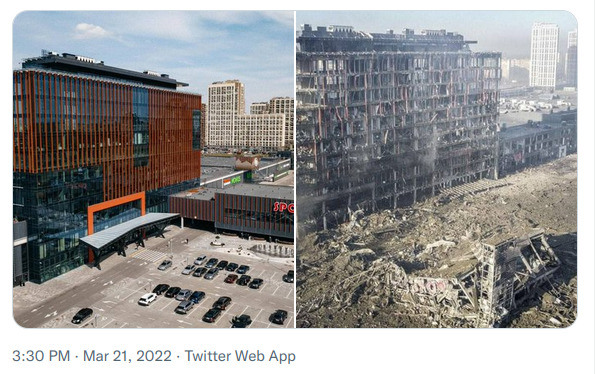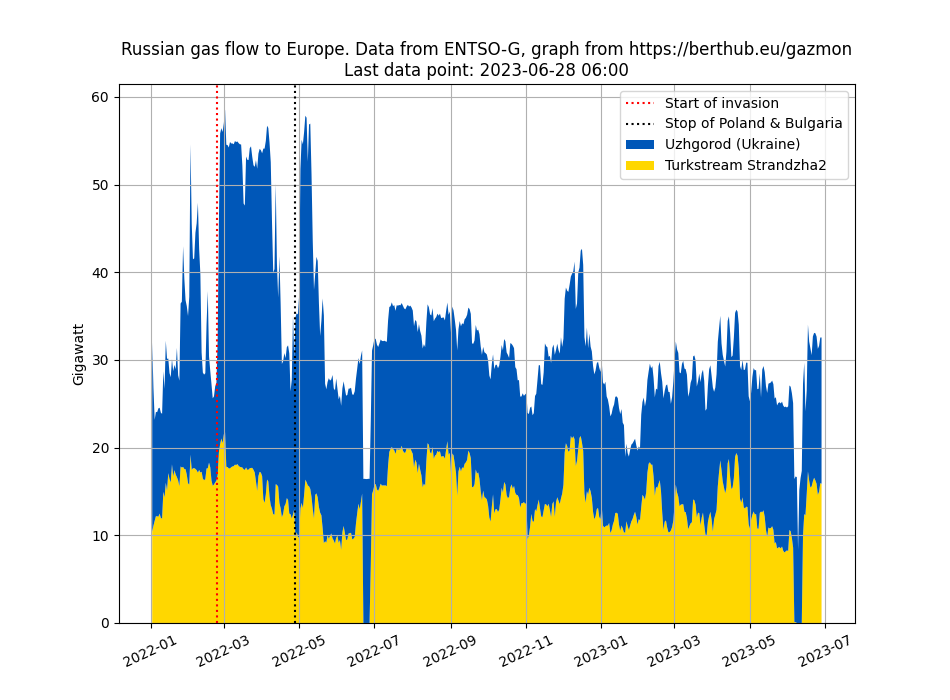About That Russian Gas
The horrors of the Russian war on Ukraine continue unabated. Every eurocent we send to Russia is an intolerable assault on the senses.
The world buys lots of things from Russia. For some of these, if Europe does not buy them, someone else will. But there is one major exception: natural gas.
Over the past few weeks I’ve been automating graphs that show, on an hourly basis, just how much gas we buy from Russia:

As I write this post, this represents around 250 million euros per day of Russian gas being bought by Europe. We buy smaller but still very significant amounts of Russian oil and coal as well.
So how does that gas get here? Through a limited number of large and extremely expensive pipelines:

Major Russian gas pipelines to Europe. By Wikipedia user Samuel Bailey (sam.bailus@gmail.com) - Own work, CC BY 3.0
These pipelines also show up on the graph above, and they go by various names: Nordstream 1/“Greifswald”, Yamal/Jamal/Jagal/Mallnow, Velke Kapusany / Uzhgorod /Urengoy–Pomary–Uzhhorod, Turkstream.
As of today (21st of March 2022), Europe imports around 140 gigawatts of energy through these large and very expensive pipes. Crucially, these pipes are custom built for us, to the point that we actually financed the construction of most of them. We even own parts of these networks.
If we stop buying Russian oil, they’ll find someone else to buy it. If we stop buying this Russian natural gas… it has nowhere else to go. The pipelines to other buyers simply aren’t there. And it turns out that even if you are not sanctioned and can hire the best of the best, it easily takes a whole decade and tens of billions of euros to lay new pipelines (to China for example).
It is also possible to liquefy natural gas and transport it by sea to alternative buyers, but similarly, this requires the construction of huge amounts of infrastructure that simply isn’t there today for these Russian fields. And the people that could build it for you are prohibited from doing so because of sanctions.
In other words, if we stop buying this 140 GW of natural gas, it truly matters since it has no other place to go.
So how much is that?
140 GW is a stonking amount of power. This corresponds to around 70 GW of electrical power, because even with the best gas powered electricity generators electricity generation is ~50% efficient. 70 GW is around 5 times more than the peak electrical power use of The Netherlands. It is more than the entire electricity use of France. 70 GW is around 70 typical nuclear power generating units operating at full blast.
Gas is used for many things: heating of houses and offices, electricity generation. There is also significant industrial use.
If we exclude Russia, Europe has around 600 million inhabitants. Since we’re going to be making rough estimates here, let’s make that 500 million.
This means that every one of us here uses 280W of Russian gas, non-stop. If all of that was electricity, it would be around 140W, which is not far removed from our whole domestic electricity use (per person).
This means that if you wanted us to stop buying Russian gas based on a decrease in electricity use alone, you’d have to stop using any electricity at home at all!
Or in other words, we aren’t going to stop Russia quickly by switching to LED lights alone.
Heating
In winter, Europe burns through stunning amounts of natural gas to stay warm. Averaged over a year, a Dutch household with a natural gas connection consumes over 1.2kW of gas on average. Since this is not electricity, this should be compared against our 280W of Russian gas consumption. Clearly, turning down our heating, improving our isolation or heating our houses more efficiently is going to make a dent in at least the Dutch need for Russian gas.
Storage
Now here is where it gets somewhat interesting. During regular summers, we buy lots of natural gas to fill up our reserves. And boy are these reserves stupendously large. They routinely deliver 350 GW of gas in winter, for days at a time.

Data from Gas Infrastructure Europe
Here we can see that we sometimes have the equivalent amount of a whole year of Russian gas supplies in storage. The filling of the gas storage happens at around 100-200 GW during summer, again comparable to the amount of Russian gas we buy.
In other words, if we’d stop buying Russian gas right now, we would likely not have an immediate problem. But we would at the end of summer be looking at a severely depleted gas storage, which would set us up for pain and disruption this winter. More about this later.
The Groningen gas field
Now here is where it gets personal. Here in The Netherlands, we sit on top of one of the largest gas fields in Europe. We have somewhat of a shameful history with this field. Its depletion has been causing (minor) earthquakes, damaging houses and causing considerable stress for the people living there. For a decade, our government and our gas industry ignored or even denied this. Although we do recognize now that these earthquakes are caused by the exploitation of the Groningen gas field, we’ve been extremely tardy in compensating the inhabitants and strengthening their buildings.
Combined with environmental concerns, the Groningen field is now close to being shut down, even though it is not depleted by any means. As late as 2013, the field was producing 54 billion cubic meters/year, or around 55 GW, compared to around 12 GW today. This was a policy based decrease, although it seems reasonable to assume production capacity also decreased through lack of maintenance and investment.
Even taking that into account, even a partial ramp-up of Groningen could put a big dent in at least the Dutch need for Russian gas, at the cost of potential earthquakes in The Netherlands.

Kyiv, 21st of March 2022
Is it ok to fund a war of attrition in Ukraine with tens of thousands of deaths because of worries about earthquakes? The Dutch government has stated Groningen production will only be increased if there is no other alternative - perhaps when we run out of gas in October or November 2022.
The REPowerEU plan
Could we find ways to reduce our consumption of (Russian) natural gas quickly?
The European Commission sure thinks so:
“REPowerEU will seek to diversify gas supplies, speed up the roll-out of renewable gases and replace gas in heating and power generation. This can reduce EU demand for Russian gas by two thirds before the end of the year.”
You have to hunt a bit for how they propose to achieve this by the end of 2022, but in this document we read that the savings are proposed to come from:
- Buying liquid natural gas (LNG, ~50 GW)
- Speeding up power sector deployments of solar and wind energy (~20 GW)
- Turning down thermostats (~14 GW)
- Diversifying to other natural gas pipelines (~10 GW)
- Boosting biomethane production (~3.5 GW)
- Speeding up rooftop solar panel deployments (~2.5 GW)
- Accelerate deployment of heat pumps (~1.5 GW)
Their numbers are expressed in billions of cubic meters of natural gas (bcm). It turns out 1 bcm/year is around 1 GW.
Curiously, this list makes no mention of ramping up production from other European fields like Groningen, or smaller North Sea fields that could conceivably deliver tens of GW as well, even if we don’t extract the maximum amount of energy.
Meanwhile, two of these measures could start today - turning down thermostats (14 GW) and not buying literally all the natural gas Russia is willing to sell us (10 GW).
Other measures would take more time to scale up. For example, we read that Germany has come to an agreement with Qatar for buying LNG even though as yet there are no terminals to receive that LNG.
Interestingly, the ‘REPowerEU’ plan does not mention the curtailing of non-essential industries, like for example flowers, which in The Netherlands burn through tons of gas. Also not mentioned is temporarily restarting coal fired power plants. This of course has environmental consequences, but so does prolonged warfare.
So, what could happen?
As of March 2022, we are buying all the natural gas Russia is willing to sell us. I think the idea, also expressed by the European Commission, is to take that gas to fill our reserves so we won’t get cold next winter. We’d best hope Russia agrees with that plan, by the way. And it might not even work – most parties performing maintenance or providing equipment and replacement parts for the pipelines are prevented by sanctions from doing so.
The effect of this plan is that we are going to continue to send hundreds of millions of euros per day to Russia, in hopes that in a few years we won’t have to do so anymore.
In this we are taking an approach that tries to minimize the risk to us, and maximizes the amount of money Russia receives while we are trying to sanction them in other ways.
Alternatively, we could stop buying Russian gas right now and force ourselves to really get our act together over the course of the year. And yes this entails the risk of earthquakes and a possibly frosty winter. But we have 7 months to prepare.
I’m sure we can achieve a lot of we put our minds to it.
Because every cent we send to Russia right now contributes to murder on a ridiculous scale. And it is especially painful that instead of at least doing something right now, we are only increasing our purchases!

What to do?
The very least we can do is widely share the fact of our only increasing purchases of Russian gas. Don’t let anyone get away with excuses - we are not reducing our purchases of Russian gas right now.
Further reading
- Bruegel on European natural gas imports - very comprehensive report
